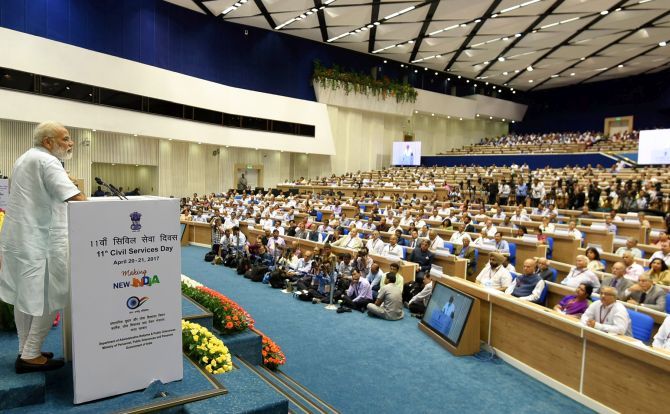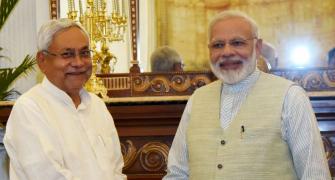Their discontent stems from the central government’s recent move of bunching two batches of the Indian Administrative Service -- 1987 and 1988 -- for the post of additional secretary and its equivalent, report Sahil Makkar and Ishan Bakshi.

Recent changes in the policy on promotion and appointments of top bureaucrats in the central government have left many feeling unhappy.
Their discontent stems from the central government’s recent move of bunching two batches of the Indian Administrative Service -- 1987 and 1988 -- for the post of additional secretary and its equivalent.
That was a sequel to, only two months earlier, the combining of the 1984 and 1985 batches for empanelment for secretary-rank charges. Made under what is termed a '360-degree' policy, entailing a 'holistic' approach to appointments than only relying on the annual confidential report.
At the time, the government had promoted 32 officers of the 1984 batch and another 41 from the 1985 batch as secretaries or equivalent.
Now comes the bunching of the 1987 and 1988 ones. It has divided the officers, with those promoted by overlooking of automatic seniority saying it is a good move.
"A lot of joint secretaries from the 1987 batch were left out in the recent round of appointments to additional secretary. They feel demoralised,” said a senior official. “This is affecting their work and percolating to junior officers around them.”
A JS is the head of the division/department in a ministry, tasked with drafting and implementing of policies. And, to be coordinators between Centre and states.
An AS ranks above, with a secretary higher. In some cases, a special secretary is appointed between an AS and the secretary.
Of the 111 officers in the 1987 batch, the government promoted only 30 to AS and gave another nine an equivalent rank.
Of the total of 39 promoted, six are from the Madhya Pradesh cadre and four from the Uttar Pradesh.
From the 1988 batch, of 105 officers, 33 have been appointed AS, with another four given equivalent rank. Of those promoted officers, five are from the Gujarat cadre and another nine are equally from those of Haryana, Maharashtra and UP.
The traditional practice has been a batch-wise promotion.
“Those not promoted in the 1987 batch have been denied seniority. Every officer usually aspires to retire from the position of secretary but their chances of reaching that have now become slim,” said another senior officer.
The ones left out may appeal for a review, through the department of personnel and training. Not many are likely to succeed, an officer said.
To placate the bureaucrats, the government on Friday gave promotions to 35 officers belonging to 1984, 1985, 1986 and 1988 batches of IAS officers. Of the promoted 35 officers, the majority were JS from the 1987 batch.
Some contend that the bunching of batches was to create a wider pool and to give officers a longer tenure. Often, the criticism has been that officers don’t have much service left when promoted to secretary.
For instance, Ashok Lavasa, a 1980-batch officer of the Haryana cadre, was appointed finance secretary on May 31, 2016. He retires at end-October this year and will not be involved in preparing the next Union Budget.
Similarly, Snehlata Shrivastava, currently secretary, law and justice, is serving on a 16-month tenure, ending this September. Currently, only four -- cabinet secretary, defence secretary, foreign secretary and home secretary -- are to get a fixed tenure of two years.
The officials quoted above said the new policy would also create more vacancies at the Centre, as some who were denied promotions are thinking of returning to their home state.
Recent reports have said that in response to huge shortages at joint secretary and below rank positions, the government is thinking about inducting outsiders into the system.
IMAGE: Prime Minister Narendra Modi addresses at the 11th Civil Services Day function in New Delhi on April 21, 2017. Photograph: Press Information Bureau.










